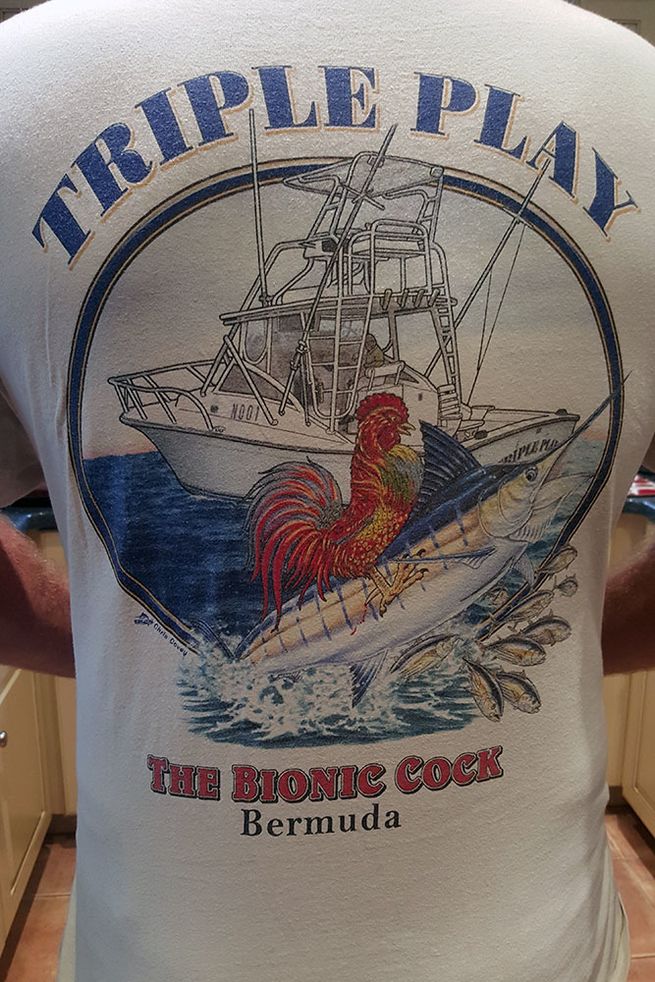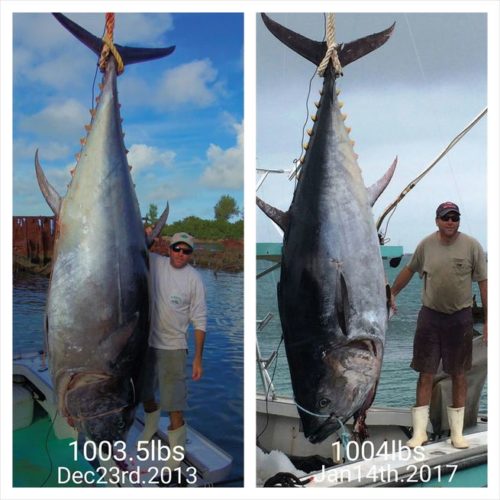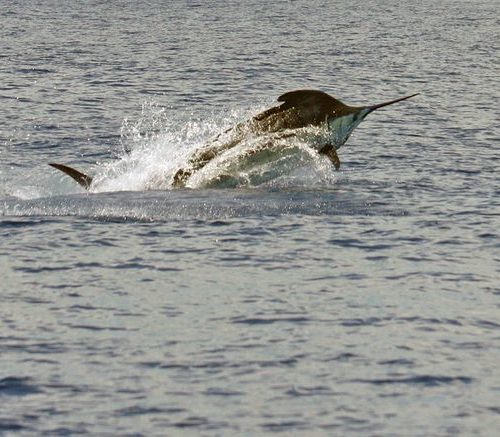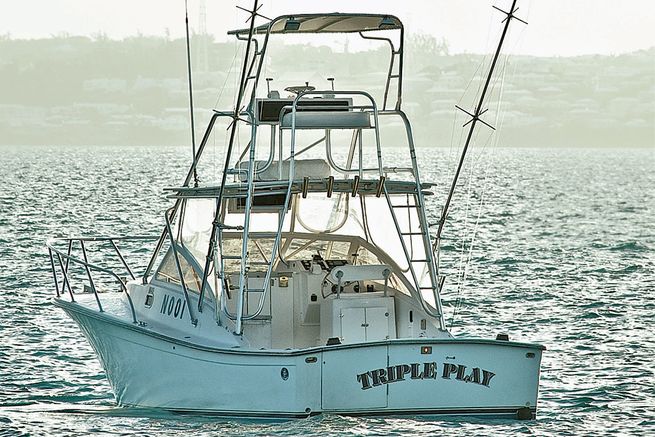
How one local Bermuda fishing team continues to defy the odds against much bigger adversaries.

1 of 6
Cheering for the underdog is a recurring theme in traditional sports, especially the amateur ranks. Fans connect when a team exceeds expectations because of raw talent, a little luck and the will to win despite the odds. Competitive big-game tournament fishing has its share of underdogs too and for the last 15 years in Bermuda, the Tripleplay team has fit the profile. Only there was one slight twist. Teammates Andrew Dias and Martin Estis never considered themselves underdogs and their subsequent tournament track record definitely backs that attitude. Just look at the scorecard.
With Dias at the helm of his 34 Offsoundings sportfish express and Estis in the chair, Tripleplay caught the largest fish in the 2003 Sea Horse Anglers Club Billfish Tournament with a 731-pound blue. That earned the team an entry into the 2004 World Cup Tournament, which they won with a grander tipping the scales at 1,189 pounds. It was the second largest fish weighed in World Cup tournament history. Tripleplay would go on to win the inaugural Billfish Blast in 2005 and it was the only team to catch the largest fish in the Big Game Classic twice with an 856 in 2013 and a 934 in 2016. In the 16-year history of the Bermuda tournament series, Tripleplay has weighed nine qualifiers, including several daily winners, more than any other team. That's not really surprising, though, since both men started training so early.
"We're grass hut natives, born and raised on the island," Dias says with a laugh. "We've been fishing for as long as we could hold a rod and line. Before we started in tournaments we were commercial fishermen. We'd go after tuna, swordfish, yellowtails, wahoo, whatever was in season before we settled into our current careers. Our shift to the competitive circuit took off after I bought my boat in the late 1990s."
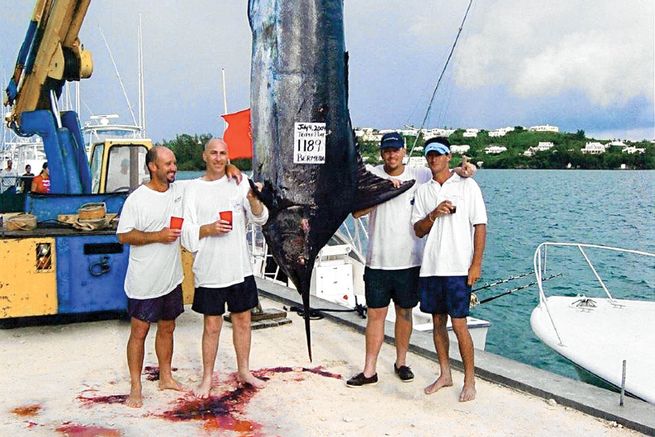
Dias is now the general manager/chief executive officer for the West End Development Corporation, operators of the Royal Naval Dockyard and marina on the island. Estis is the owner of A&M Construction Ltd., which was named Bermuda's top contractor in 2016. The men's successful business careers have carried directly over to similar achievements on the sport-fishing circuit.
When he got ready to purchase his boat, Dias settled on the Offsoundings, a limited production express built on Long Island, New York. Powered by twin CAT diesel engines, it was the third boat out of the mold and was destined to become his leisure toy, hence the name Tripleplay.
"I joined Andrew in 1998 and we fished the World Cup and Sea Horse tournaments," Estis recalls. "Our main focus was landing a big blue and over the next few years we released several large fishing during recreational trips. We'd make half-day trips to test the tackle and lure spread. After we had good success raising blues over the 500-pound bracket, it was only a matter of time before we had the big one. Andrew always said we'd catch our grander in less than five years and 2004 was the year."
"We started off fishing just the two tournaments at first," Dias added. "After seeing a couple big marlin you get hooked yourself and we never looked back. We kept adding tournaments after that, but we didn't just concentrate on the kill division, we released fish too. Typically, we go all in on the different entry levels."
Tripleplay was outfitted with a fighting chair and outriggers and Dias increased his tackle inventory a rod at a time. After winning the World Cup tournament with the grander on a Penn International, he took the winnings and bought all new Shimano Tiagra 130 reels (still in use), matched to Capt. Harry's custom bent-butt rods.
Although some boats have experimented with live baiting, the majority of Bermuda teams prefer to drag large plastic lures. Dias was given a hand-em-down Big T lure from another angler and liked it. When another local skipper, Capt. Ian Card, received a large shipment direct from the manufacturer, Dias and Estis were able to pick out a few before eventually ordering more direct. The 1,189 and 731 fish were both landed on the same battle-scarred Big T Leopard lure. The only other choice in the spread besides Big Ts are Mold Craft Wide Range plungers.
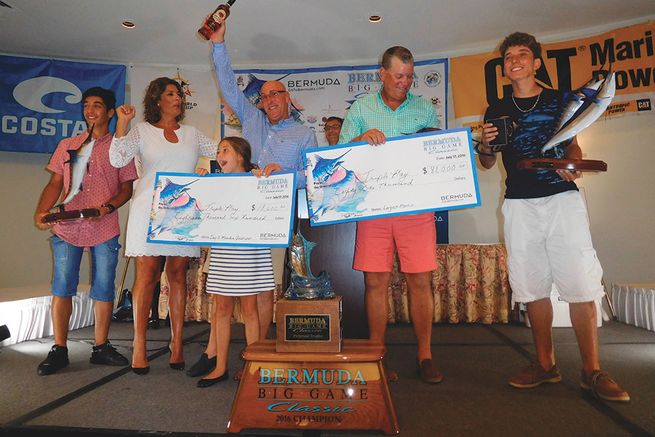
"We mix up our colors with purples, blues, blacks but never more than one pattern," Dias says. "We also usually have an ugly color out there like pink and white. But for some reason our fish really love that African plastic."
Estis says the big fish typically hone in on a certain color, although he feels presentation is more critical than appearance.
"It's more about the way the lure swims," he says. "You can have two identical lures, but if the hook set on one is just a little off you won't get bit. Boat speed has to be spot on, too. One-half a knot can make a big difference. It all depends on the weather and currents. You have to be ready to make adjustments. How the lure looks as it's moving through the water is the key."
Dias and Estis use 11/0 to 12/0 Mustad hooks in a 180-degree double hook arrangement after experimenting with several other brands. The lighter gauge hooks swim better with the lures, they've found. Single hook rigs are sometimes added to the long center rod. The normal pattern on Tripleplay is five rods with lures on the first, second, fourth and fifth waves. The last line is run way back off the center 'rigger rod. No dredges are used and the team only deploys one teaser, which may be something as simple as an empty rum bottle.
Dias is switching to Amelion 130-pound monofilament line this year after losing the junior angler world record (Martin's son Jacob was on the rod) on the 934 last season when his previous line brand over-tested. The strike setting is 8 to 12 pounds of drag.
"We use 550-pound test clear monofilament leader plus I use crimps instead of clips to avoid failure," Dias explains. "I also tie Dacron loops or socks on the main line and add a piece of 8- to 12-pound mono with twin loops. The light mono line connects to longline snaps on the tag lines and it breaks every single time at the same pressure. When we have a knock-down, we can quickly put the line right back in the sock so it's in the exact spot every time."
"After the strike we maintain the same drag with even pressure and clear the deck while Andrew starts backing down," Estis says. "Once the fish settles down after the initial run, I bump the drag up to between 35 and 60 pounds of pressure. If the fish comes up and starts jumping again, I may loosen the drag some, but it's all about knowing the angler's capabilities and teamwork. You have to keep the heat on the fish. You can quickly tell the size of the fish by the fight. The ones less than 500 pounds make quick spurts and tire out fast. The 800 and 900 pounders are usually pretty easy as well. It's those between 500 and 800 pounds that are really hard. They are wild, mature fish and it's a totally different fight. My longest was 1 hour 45 minutes on the 731. If you keep a fish on for more than 30 minutes, it's usually a keeper and most of our fights last a little over an hour with the higher drag settings we use."
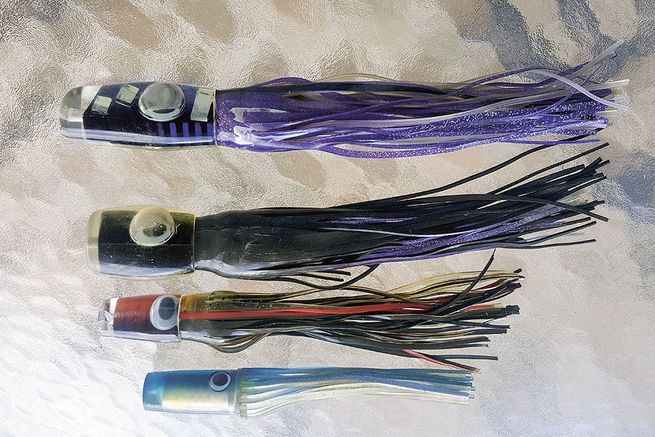
Dias is very methodical at the helm as well.
"I don't do anything crazy and take my time backing down, especially towards the end of the fight," he says. "One good thing about owning a smaller boat is its maneuverability. I can spin Tripleplay quickly if I have to."
Last year Martin's son Jacob took over the primary angling duties, shifting dad to first mate chores. Andrew's son Morgan has also been a key angler and team member over the years, along with friends.
"It always helps to have Lady Luck on your side so we usually have either of our wives on board, depending on the weather," Dias adds. "During one trip last year we had a junior in the chair, a wife sitting on a bucket fighting a fish when another big fish popped into the spread. We had our hands full already so I wasn't about to offer another lure to it."
Dias and Estis both agree local knowledge and their commercial background has contributed to their enviable tournament success rate.
"First, you've got to find the fish and get it to eat before you can catch it," Dias explains. "Most of us fish the edge around Bermuda and the Challenger and Argus Banks to the southwest. We've won tournaments at every one of those locations. It all depends on the conditions. We'll plan accordingly and then go either north or south. Bermuda offers some of the best shots in the world for catching a grander. It just consistently produces. Will you get the chance for 10 fish a day like St. Thomas or some other places in the Caribbean? No. But we're not looking for 10 fish. We want to catch the single biggest fish that swims in the ocean."
Dias says he and Estis have a good relationship with the visiting American boats. They've shared tips and techniques and enjoy the camaraderie the tournaments offer.
"I truly believe we have some of the best anglers in the world right here, bar none," Dias adds. "But we all fish for the love and passion of the sport. We do like to win, but it's not just about winning. We've shown a lot of boats what we use and we've learned from them too. It's got to be fun. If you're not having fun out there, you need to turn up the music and mix another drink."
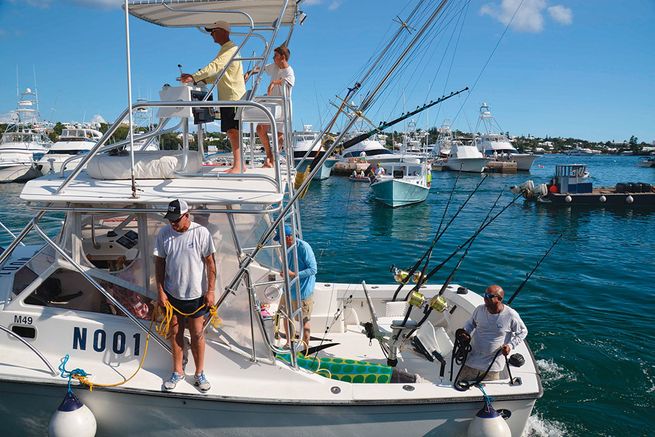
The focus isn't simply on fun, killing fish and prize money, however. It didn't take long to discern how much these two men respect the giant animals they pursue. Non-trophy fish are gladly released and Dias stated that on the average only 10 fish per season are boated during the tournaments, an insignificant amount compared to the commercial by-catch on longlines.
A positive approach is another key element to Tripleplay's consistent success. Estis says the team is always confident it will catch a fat, contending fish if the tackle is set properly and all members execute according to the game plan. They don't worry about what other boats are doing.
"As the main angler until recently I have learned a lot over these past 15 years with regard to drag settings, hook settings and how to present the lures. This all plays out in raising big blue marlin consistently. Our goal is to catch the Atlantic world record blue marlin. That's the fish we target every year. Andrew and I have always wanted to fish the full marlin season, from June through August. On the average now though we only manage seven to 12 trips. But when we go, we make every one count."
"I don't look at us as underdogs," Dias adds. "We're not intimidated and we have no fear. We just do what we've got to do. We know how to catch fish."
Is that boasting? Not when you have the track record to back it up. It's simply the Tripleplay way.
